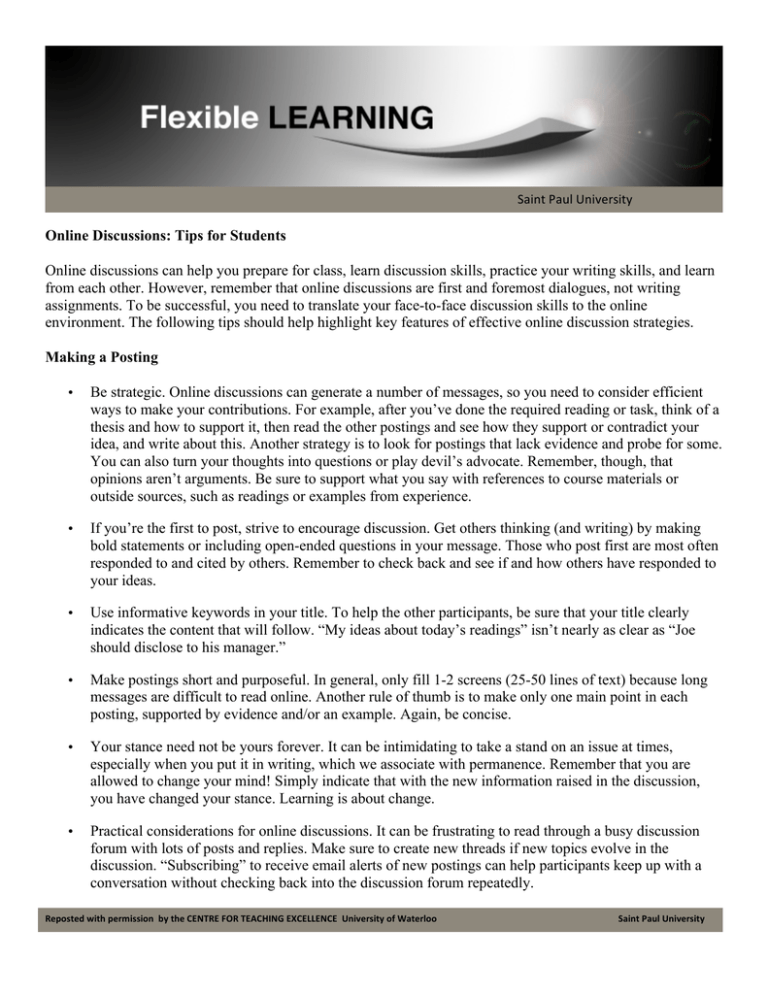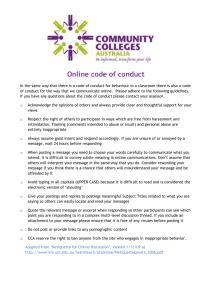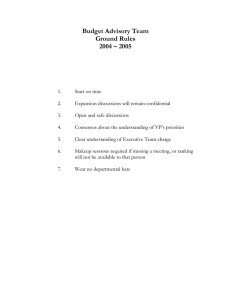Online Discussions - Saint Paul University
advertisement

Saint Paul University Online Discussions: Tips for Students Online discussions can help you prepare for class, learn discussion skills, practice your writing skills, and learn from each other. However, remember that online discussions are first and foremost dialogues, not writing assignments. To be successful, you need to translate your face-to-face discussion skills to the online environment. The following tips should help highlight key features of effective online discussion strategies. Making a Posting • Be strategic. Online discussions can generate a number of messages, so you need to consider efficient ways to make your contributions. For example, after you’ve done the required reading or task, think of a thesis and how to support it, then read the other postings and see how they support or contradict your idea, and write about this. Another strategy is to look for postings that lack evidence and probe for some. You can also turn your thoughts into questions or play devil’s advocate. Remember, though, that opinions aren’t arguments. Be sure to support what you say with references to course materials or outside sources, such as readings or examples from experience. • If you’re the first to post, strive to encourage discussion. Get others thinking (and writing) by making bold statements or including open-ended questions in your message. Those who post first are most often responded to and cited by others. Remember to check back and see if and how others have responded to your ideas. • Use informative keywords in your title. To help the other participants, be sure that your title clearly indicates the content that will follow. “My ideas about today’s readings” isn’t nearly as clear as “Joe should disclose to his manager.” • Make postings short and purposeful. In general, only fill 1-2 screens (25-50 lines of text) because long messages are difficult to read online. Another rule of thumb is to make only one main point in each posting, supported by evidence and/or an example. Again, be concise. • Your stance need not be yours forever. It can be intimidating to take a stand on an issue at times, especially when you put it in writing, which we associate with permanence. Remember that you are allowed to change your mind! Simply indicate that with the new information raised in the discussion, you have changed your stance. Learning is about change. • Practical considerations for online discussions. It can be frustrating to read through a busy discussion forum with lots of posts and replies. Make sure to create new threads if new topics evolve in the discussion. “Subscribing” to receive email alerts of new postings can help participants keep up with a conversation without checking back into the discussion forum repeatedly. Reposted with permission by the CENTRE FOR TEACHING EXCELLENCE University of Waterloo Saint Paul University Flexible LEARNING Université S aint-­‐Paul Responding to Other Postings • Make the context clear. An informative title will help, but also consider including a quotation from the original message that you’re responding to. If the original message is lengthy, cut out what is not relevant to your response. And if the original has many paragraphs, place your comments between the paragraphs to give readers the context for your ideas. • Add value to the conversation. Saying “I agree” does not move the discussion forward. Ask yourself why you agree and explain your rationale so that others have something else to respond to. • Ask probing questions. Consider using the following samples when trying to extend a discussion: o o o o o o o What reasons do you have for saying that? Why do you agree (or disagree) on that point? How are you defining the term that you just used? What do you mean by that expression? Could you clarify that remark? What follows from what you just said? What alternatives are there to such a formulation? • Feel free to disagree with your classmates. To air different perspectives or help others clarify their thinking, you may need to contradict a classmate. Remember to disagree respectfully (no name-calling or obscenities) and support your point with evidence, but do not feel bad about offering a different interpretation. Your contribution should help to make the discussion more productive for all involved. • Work to create group cohesion. Discussions are about group learning. When you function well as a group, you will be more open to all the benefits that this type of learning can offer. Give positive feedback to one another, use light humour, avoid comments that could be taken as insulting, use first names, respond promptly to each other, and offer assistance. Also remember the lack of nonverbal and vocal cues in the online environment. You’ll need to label emotions (“I’m confused about this” or “I feel strongly”) because no one will pick up on how you feel otherwise. • If you feel very emotional about a message, wait before responding. It’s very easy to write something in the heat of the moment and then wish you could retract it. If you send it to the discussion, the damage is done. Even waiting overnight can give you enough distance to respond in a calmer and more professional manner. Developing a Positive Perspective • Be open to new ideas. Discussion is about hearing what others have to say and working to shape and reshape your own thoughts and perspectives. Different perspectives can further everyone’s understanding of the issue or concept being discussed – they represent opportunities for learning. Reposted with permission by the CENTRE FOR TEACHING EXCELLENCE University of Waterloo Saint Paul University 2 Flexible LEARNING Université S aint-­‐Paul • Enjoy yourself. The online environment comes with many benefits, including learning from your peers in addition to your instructor. Use the time productively to hone lifelong skills and refine your ideas about the course content. Reposted with permission by the CENTRE FOR TEACHING EXCELLENCE University of Waterloo Saint Paul University 3


